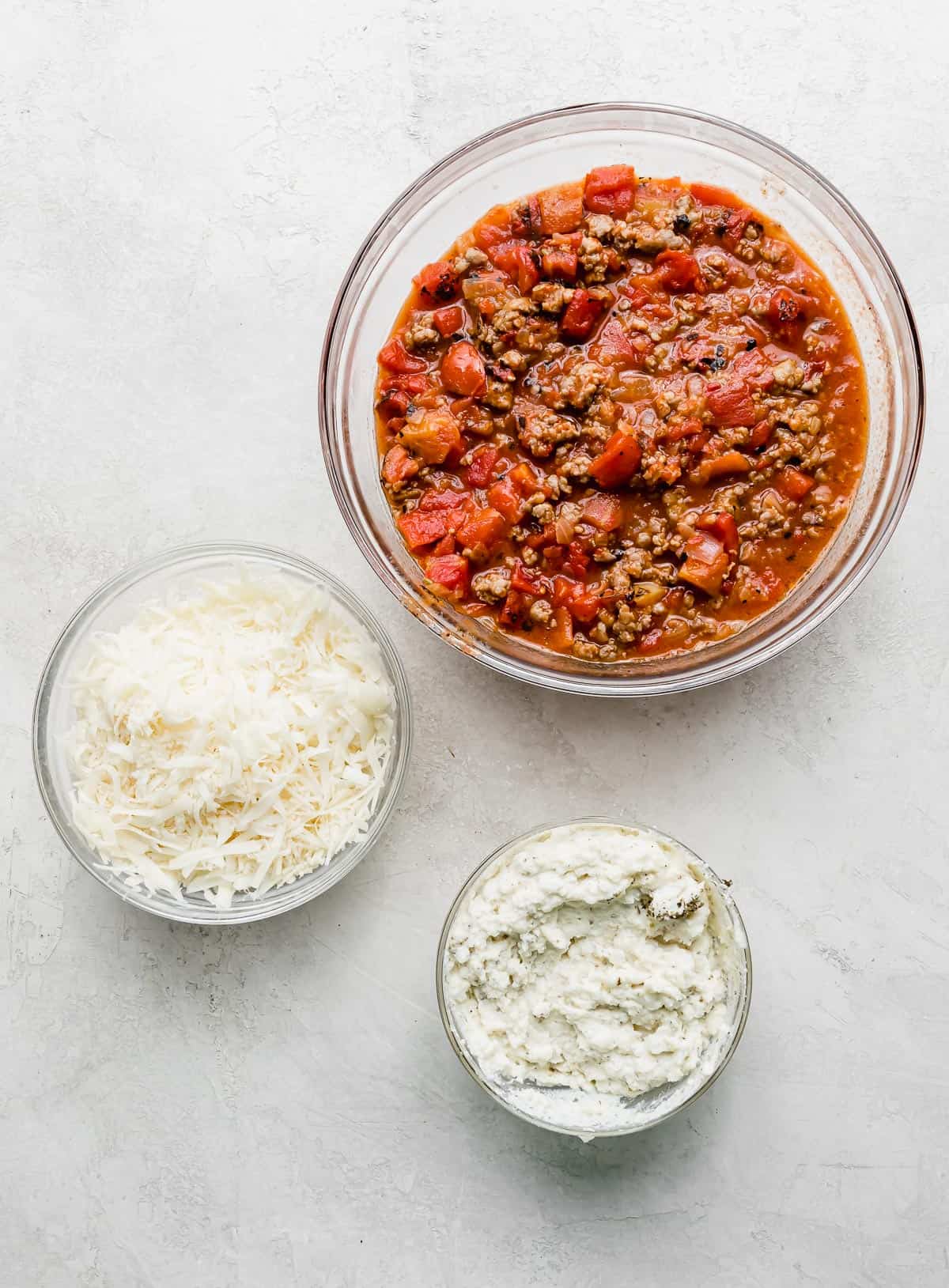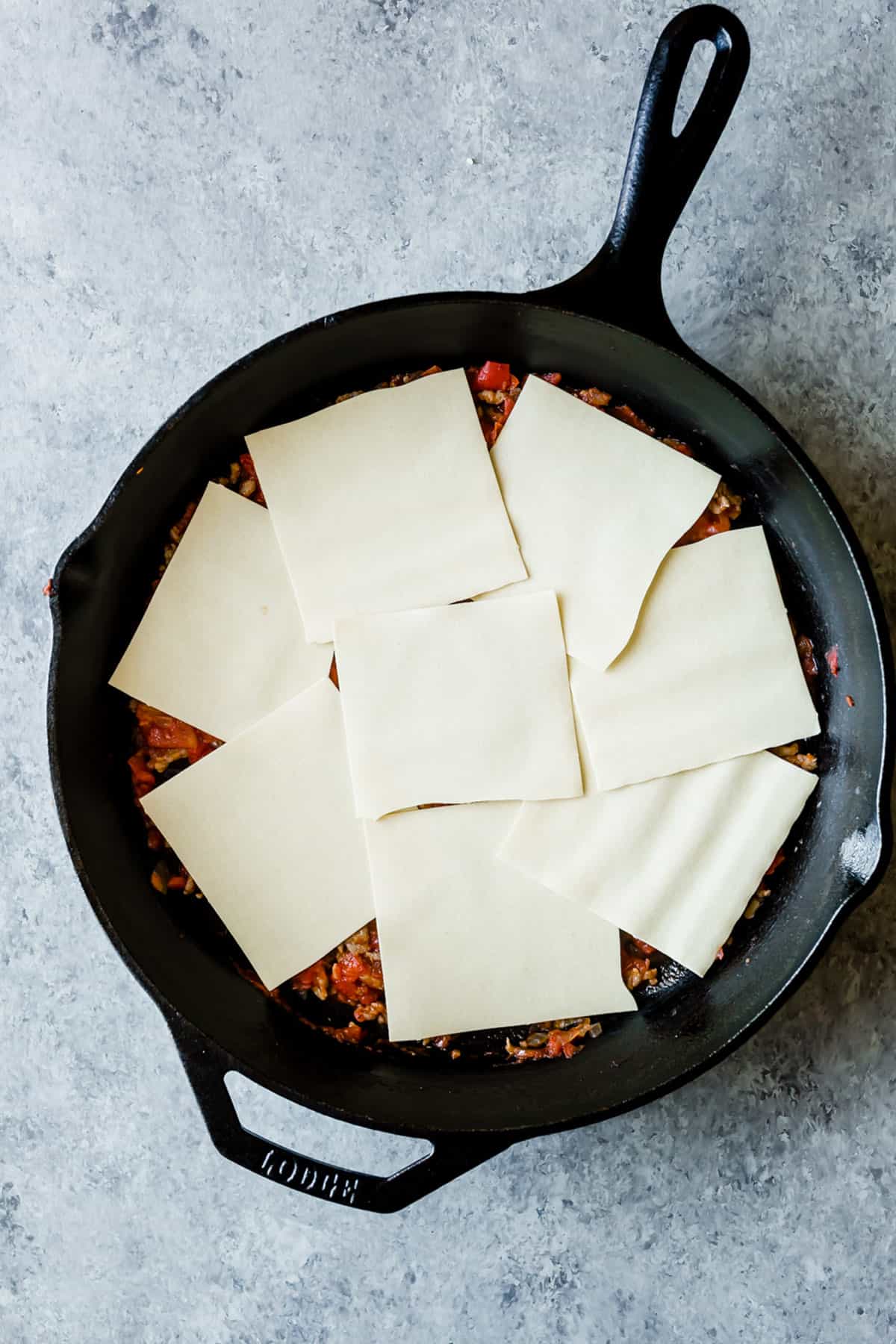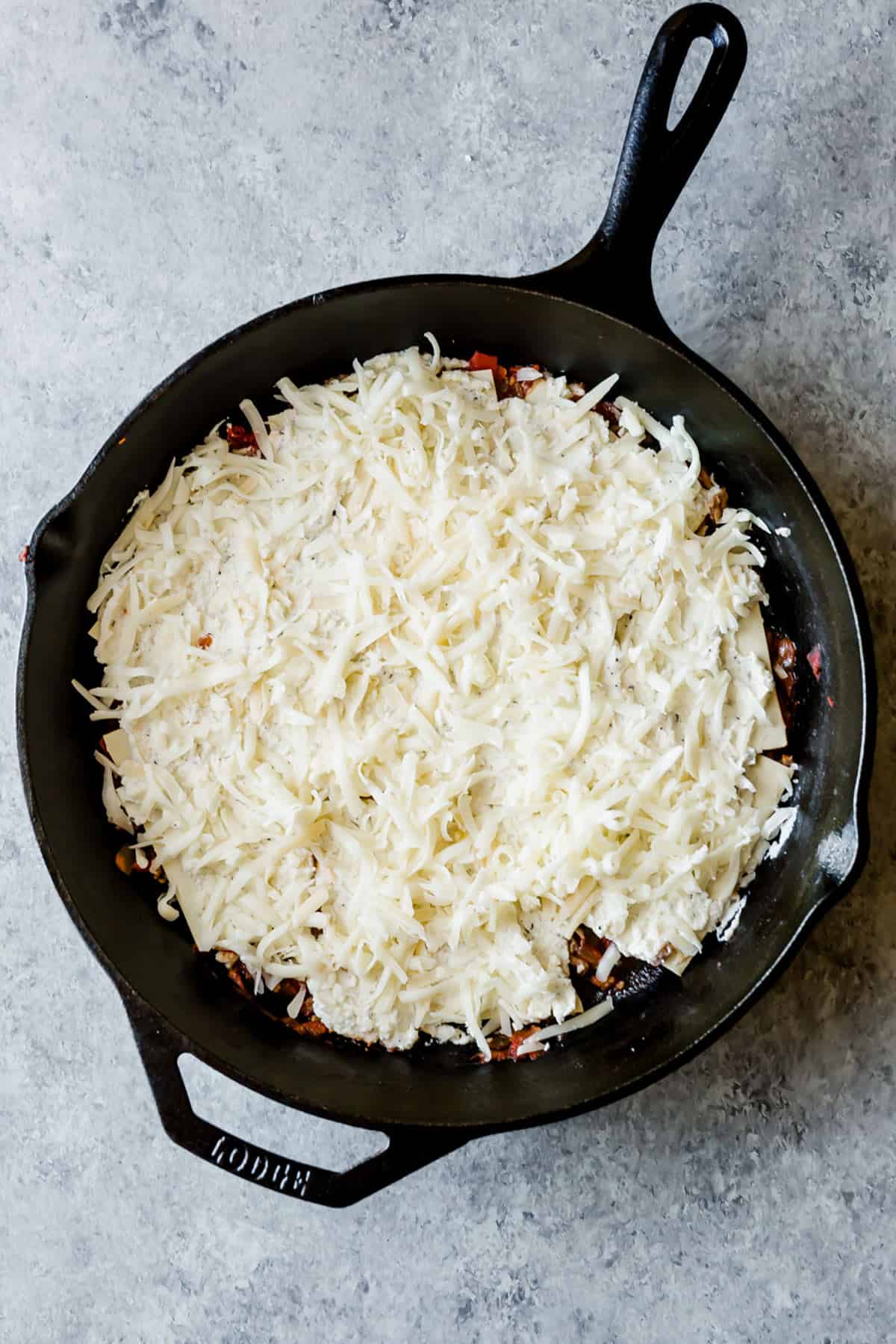Cast Iron Lasagna
Introducing, the most amazing cast iron lasagna recipe! Bursting with flavor, this lasagna recipe has a delicious sausage and tomato ragu, a creamy herbed ricotta filling and uses no-boil lasagna noodles for a hassle-free meal!
Lasagna is one of the great comfort food joys in life! So why not have it in multiple forms? Try my slow cooker lasagna, lasagna soup, or my Mexican lasagna for a fun twist!

Why This Recipe Works
- No need to pre-cook the lasagna noodles. This recipe uses no-boil lasagna noodles which means you don’t need to pre-cook the noodles before layering them in the lasagna. Huge win!
- Flavor heaven. I’ve made a lot of homemade lasagna in my day and this one is the winner. So many elements of this lasagna are little slices of flavor heaven. The meat ragu is made with Italian sausage which adds tons more flavor to the meat mixture than if using regular beef. The fire-roasted diced tomatoes bring a delicious smoky flavor to the sauce as well. Then don’t even get me started on the herbed ricotta mixture! 😍 I could eat that plain no problem.
- Easy skillet recipe. I really, really, really love that this lasagna is made in a skillet. I’ve linked the skillet I use because one, it’s amazing! And two, it’s affordable.
Ingredient Notes

- No-Boil Lasagna Noodles: These are lasagna noodles that have been precooked and then dehydrated. It means they cook up quicker and more easily since they are already cooked and just need to be rehydrated. They soak up the sauce and soften.
- Fire-Roasted Diced Tomatoes: These aren’t spicy although their name makes it seem like they are. Fire roasted diced tomatoes just have a bit more flavor and spices to it, including a nice smoky flavor.
- Ricotta: “Ricotta” mean recooked in Italian, which describes what kind of cheese it is. It’s a recooked mixture of the whey from other cheeses like cow, goat, sheep or buffalo.
- Italian Sausage: I used a classic sweet Italian sausage. However, if you want to kick up the heat, you can use hot Italian sausage.
Step-by-Step Instructions
- Make the lasagna ragu. Cook the onion in the skillet with oil over medium heat. Once soft, add the garlic, red pepper flakes and sausage. Cook until the sausage if browned then add the fire-roasted tomatoes and a bit of water. Cook the mixture for about 8 minutes on medium low heat. Transfer to a bowl.
- Make the creamy herbed ricotta mixture. Add the ricotta, egg yolk, oregano, thyme, salt, and pepper to a bowl and stir until combined.
- Combine the cheeses. Mix the mozzarella and parmesan cheeses together in a bowl.

- Assemble the cast iron skillet lasagna. Spread 1 cup of the sauce on the bottom of the skillet. Break the no boil lasagna noodles in half. Layer 7 of the halves along the perimeter of the skillet and one in the middle. Spread 1/3 of the ricotta mixture over the noodles. Sprinkle a quarter of the cheese mixture over the ricotta. Add a 1/3 of the remaining sauce over the cheese.


- Add more layers. Repeat this layering process 2 more times, starting with the noodles and ending with the sauce. Sprinkle the remaining mozzarella/parmesan cheese overtop.


- Bake. Bake the skillet lasagna at 400ºF for 30-35 minutes. Remove from oven and top with fresh basil.


Recipe Tips
If you like *major heat* then up the amount of red pepper flakes from what it calls for in the recipe OR use hot sausage. I used sweet Italian sausage. As the sausage is cooking be sure to break it up with your wooden spoon so that it’s in nice small chunks.
Make Ahead, Storing, and Freezing
If you make this cast iron lasagna recipe ahead of time, store it covered in the fridge prior to baking it. You can store it in the fridge for a few hours and up to 1 day. Then bake following the recipe instructions. Note that the lasagna noodles will have soaked up the liquid from the sauce while being stored in the fridge so they may be softer.
Note: Do not transfer a cast iron skillet from the freezer or fridge directly to a hot oven or vice versa. The dramatic change in temperature can crack the enamel. Let the skillet come to room temperature prior to storing in the fridge or freezer or prior to adding to the hot oven.
You can let the cast iron skillet warm up with your oven, just don’t put a cold skillet in an oven that is ready and hot.
If you want to freeze the lasagna in the cast iron skillet, I would instead recommend removing the lasagna from the skillet and storing in a separate container, just based off the bulky nature of the skillet and the inability to store it airtight. If freezing the lasagna, be sure to store in an airtight container or plastic bag. Reheat in the oven until warmed through.
Store the baked skillet lasagna covered in the fridge for 3-5 days. Reheat in the oven until warmed through.
FAQs
The difference between no-boil lasagna noodle and regular lasagna noodles is that the no-boil lasagna noodles are precooked and then dehydrated. This means they will soften up quicker in the skillet lasagna. If you use regular lasagna noodles, you’ll need more sauce in order for there to be enough liquid to cook the lasagna noodles since they aren’t precooked.
Nope! But if you are looking for a bit more spice, I would recommend using hot Italian sausage and doubling the red pepper flakes.
A common substitute for ricotta is cottage cheese. I’m a little picky when it comes to the ricotta herb mixture though because it is so good. I would highly recommend using ricotta, but if you aren’t a fan or want a cheaper option, then yes cottage cheese is your best bet. Just know the texture will be different and the flavor will be slightly different too.
There are a few good reasons to use a cast iron skillet! Food cooks faster in a cast-iron pan due to the incredible heat retention. Be careful when handling cast-iron pans. Why? They heat EVERYWHERE, handle included. Make sure you’re wearing oven mitts when handling the pan. Cast-iron holds on to heat very well and are very durable! If you have a cast-iron skillet, or if you choose to purchase one, you’ll have it for a lifetime. Cast-iron’s ability to develop a nonstick coating makes it very versatile and frankly, a necessity in any kitchen.

More Skillet Recipes
Did you make this recipe? I’d love to hear about it! Click here to leave a rating and review, or scroll below the recipe card and do so there.
Stay up-to-date by following us on Instagram, Facebook, and Pinterest.
Cast Iron Lasagna
Ingredients
- 3 14.5 oz cans fire roasted diced tomatoes
- 2 tablespoons olive oil
- 2 cups yellow onion - finely chopped (about 1 large yellow onion)
- 3 garlic cloves - minced
- 1/4 teaspoon red pepper flakes
- 1 pound sweet Italian sausage - casings removed
- 15 oz ricotta - (425 grams)
- 1 egg yolk
- 1/4 teaspoon dried thyme
- 1/2 teaspoon dried oregano
- salt - to taste
- pepper - to taste
- 2 1/2 cups mozzarella - shredded (a little more than 8 oz)
- 1/3 cup freshly grated parmesan cheese
- 12 no boil lasagna noodles - broken in half
- 2 tablespoons fresh basil - chopped
Instructions
- Place oven rack to the middle position. Preheat oven to 400°F.
- Place a 12-inch cast iron skillet over medium heat. Add the olive oil. Once the olive oil is shimmering add the onion and cook until lightly browned, about 6-7 minutes. Add the garlic and red pepper flakes. Add the sausage to the onions. Using a wooden spoon break the sausage up into bite size pieces. Cook until no longer pink, about 6 minutes.
- Add the fire roasted tomatoes to the sausage and onion. Cook over medium-low heat for 5 minutes. Transfer to a bowl.
- In a separate medium size bowl, add the ricotta, egg yolk, thyme, oregano, and salt and pepper to taste. Stir to combine.
- In a 3rd bowl combine the shredded mozzarella and parmesan.
- In the bottom of the empty skillet spread 1 cup of sauce. Add 7 noodle halves around the edge of the skillet and 1 noodle half in the middle. Add 1/3 of the ricotta mixture over the noodles (spread evenly over the noodles), then top with ¼ of the mozzarella cheese mixture over the ricotta. Add 1/3 of the remaining sauce over the mozzarella. Repeat this layering process two more times. Starting with the noodles and ending with the sauce. Sprinkle the remaining mozzarella cheese mixture over top. (See blog post for pictures to illustrate the process).
- Transfer the skillet to the oven and bake for 30-35 minutes, or until the edges are bubbling and the cheese is slightly golden brown.
- Remove from the oven, top with chopped fresh basil and serve.
Notes
This recipe was originally published on Nov. 2, 2018. It was republished on Jan. 10, 2022, to include additional information and photos.



 Welcome to this delicious corner of the internet! Here I share the recipes my family loves.
Welcome to this delicious corner of the internet! Here I share the recipes my family loves.














11 Comments on “Cast Iron Lasagna”
Would this recipe work if I cooked the skillet lasagna only on the stove? I’d also use fresh lasagna noodles.
Yes it should work. The oven not only helps to cook it, but also to making the cheese on top melty and golden brown. You could try using a lid for the skillet to get that effect.
My husband and I love to make this when we have a little time for cooking dessert! So good!
Can you use breakfast sausage instead of Italian sausage?
Yes you can! You may want to add a little Italian seasoning to the breakfast sausage. But not necessary.
Making this tonight! Can’t wait to eat it, smells delish.
Hi Whitney!
I’d like to make this for my family tonight. However, I only have regular lasagna noodles on hand – not the no boil. Is that going to work or should I do something differently?
Thanks!
hi! Sorry I’m replying to this just now. I would use the no boil noodles. There isn’t enough liquid in the skillet lasagna to make the regular lasagna noodles work.
This lasagna recipe is amazing! We LOVED it! Easy to make too. We fought over who got to eat the leftovers… that rarely happens.
This looks amazing! Can’t wait to give it a try. Oh and where did you get the towel in the bottom picture? I’ve been on the hunt for one like that and can’t find one (lol!). Thanks again for the yummy recipe!
Thanks for the nice comment Jodi!
The towel is from Crate and Barrel… I use it all the time. I LOVE it!!